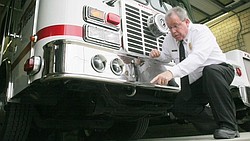Time takes its toll on Struthers fire station
STRUTHERS — The city’s 66-year-old main fire station on Elm Street wasn’t built to handle the weight of modern firefighting vehicles, and that’s beginning to show.
The main area of concern is a concrete block wall in the basement hallway under the station offices and adjacent to the vehicle bays, according to an MS Consultants engineer, who did a walk-through inspection of the station earlier this year.
There is a noticeable horizontal crack in the concrete block wall, most likely due to the lateral forces on the wall caused by the weight of the firetrucks parked in the two bays above, said Gary J. Diorio of MS Consultants.
The trucks weigh a combined 70,000 pounds, said Fire Chief Harold Milligan Jr. When the station was built in 1943, trucks weighed about 15,000 pounds each, he said.
While the vehicle bays are concrete slabs poured over earth, the sideways or lateral pressure of the weight is damaging the block wall. There is also evidence of water leaking into the hallway at the base of the wall and on the steps leading to the basement, which Milligan thinks is from a spring that was discovered on the site that was filled in when the station was built.
The station has also outlived its usefulness in other ways, said Milligan, fire chief since 1980. It does not have sufficient office and training space and sleeping facilities. Neither does it have facilities for females, he said.
Struthers has a combination department, consisting of 10 full-time employees, including the chief, and 25 volunteers, who staff its two stations: The main firehouse at 96 Elm St., and the other at 10 Frank Ave. The department has no female firefighters, but has had in the past, Milligan said.
The recommendation of MS Consultants is to not make a temporary fix until a full study is done to determine the cost effectiveness of a new fire station. The study would cost $5,000 to $8,000.
Read the full story Monday in The Vindicator and on Vindy.com
 43
43

